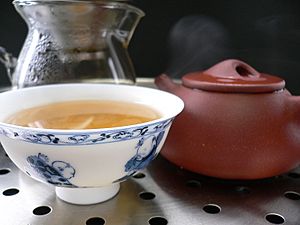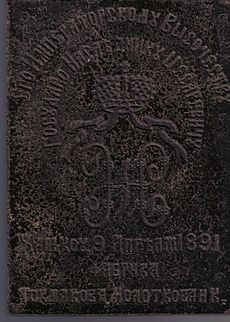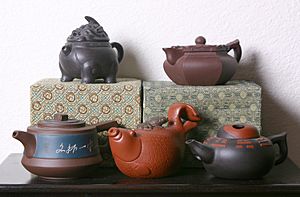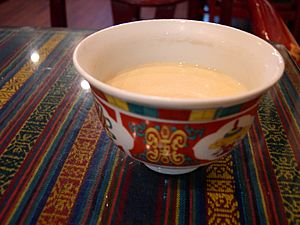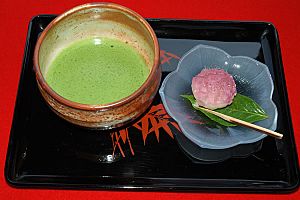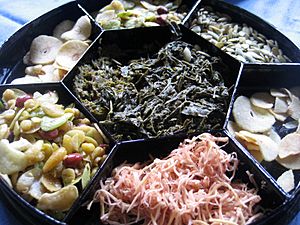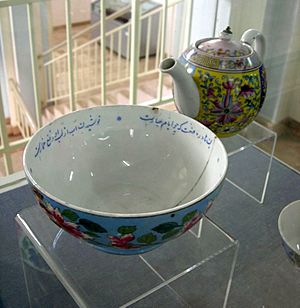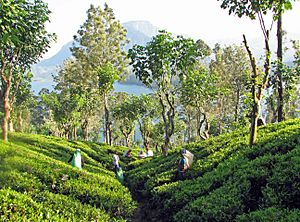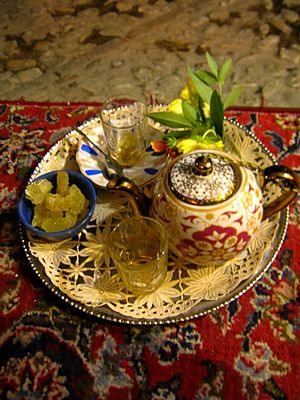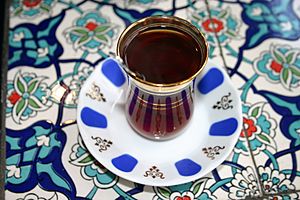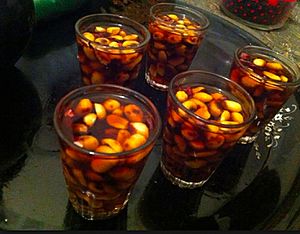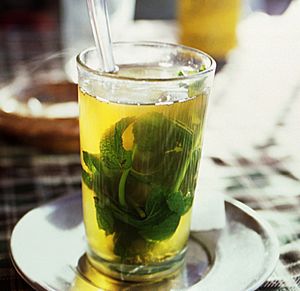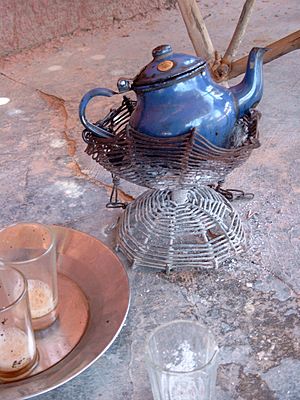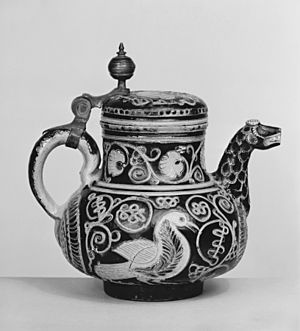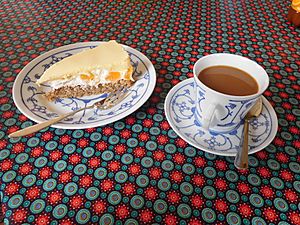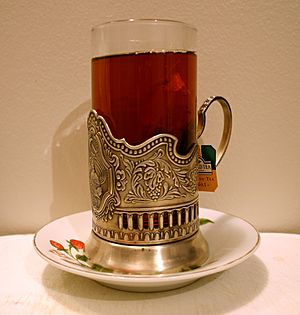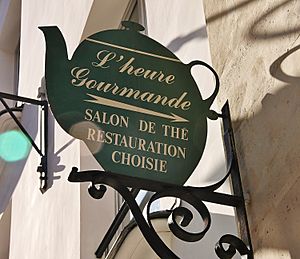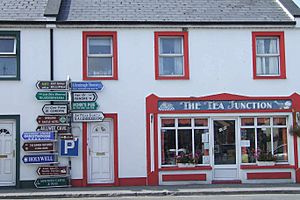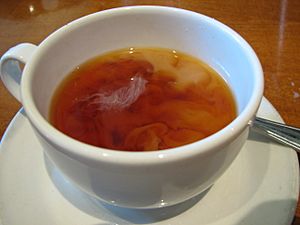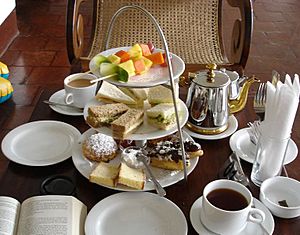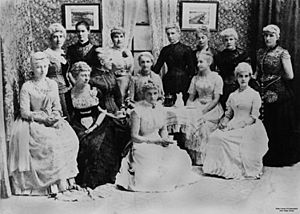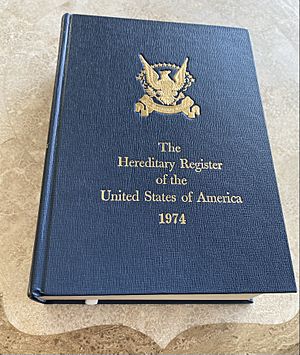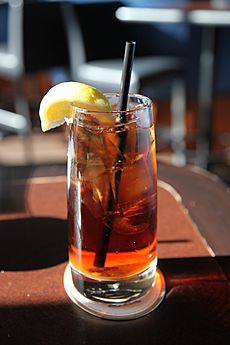Tea culture facts for kids
Tea culture is all about how people make and enjoy tea, how they interact with it, and the beautiful traditions around drinking it. Tea is super important in many countries! People often drink it at social events, and some cultures have amazing, formal ceremonies for it.
For example, tea ceremonies in East Asia, like those in Japan or Korea, come from Chinese tea traditions. They are a bit different in each country. In Tibet, tea is often made with salt and butter, which sounds unique! People might drink tea in small groups at "tea parties" or in public "teahouses" where everyone can socialize.
Afternoon tea is a popular custom in Britain. The British Empire helped spread its way of drinking tea to places like Hong Kong, India, and Pakistan, which already had their own tea customs. It also went to places like East Africa, Australia, and New Zealand, where tea wasn't a big thing before. You can find tea rooms in the US, Ireland, and many Commonwealth cities.
Different places like different types of tea – white, yellow, green, oolong, black, or dark (post-fermented) tea. They also use different flavors like herbs, milk, or sugar. The temperature and strength of the tea can change a lot too!
Tea Traditions in East Asia
China's Tea Story
Tea is super important in Chinese society. You can find teahouses in most neighborhoods and business areas. These teahouses offer many kinds of hot and cold teas. They also serve yummy snacks that go well with tea. In the late afternoon, Chinese teahouses fill up with students and business people. Later at night, they become a relaxing spot for anyone looking to chill out.
There are also fancy teahouses that offer special Chinese and Japanese teas, along with all the tools needed to make them. Then there are tea shops that just sell tea leaves, pots, and other tea items. Tea is so important in China that it's one of the "seven necessities" of daily life!
Long ago, during the Tang Dynasty, a tea expert named Lu Yu found that tea plants growing in shady spots didn't make good tea. Back then, people often boiled water and tea leaves together. They would heat the water until it looked like "fish eyes." They even added salt to make the tea taste better!
Two Big Changes in Chinese Tea In China, people started appreciating tea as a special art form very early on. During the Song Dynasty, they even had formal tea-tasting parties, much like wine tastings today. Just like with wine, the right cup or pot was very important. People paid a lot of attention to matching the tea with a beautiful serving dish.
Historically, Chinese tea drinking changed in two main ways, depending on if the tea was made into "tea bricks" or "loose leaves."
The Tea Brick Era
Before the Ming Dynasty, tea was usually made from pressed "tea bricks." After tea leaves were picked, they were dried and ground into powder, then pressed into bricks. Sometimes, these tea bricks were even used as money! Making tea from these bricks involved a few steps:
- Toasting: First, the tea bricks were often toasted over a fire. This helped get rid of any mold or bugs that might have gotten into them. Toasting also probably made the tea taste nicer.
- Grinding: The tea brick was broken up and ground into a fine powder. This tradition still exists in Japanese powdered tea called matcha.
- Whisking: The powdered tea was mixed into hot water and frothed with a whisk before serving. People enjoyed looking at the colors and patterns the powdered tea made in the bowl while they drank it.
The powdered teas of that time were best enjoyed in dark, patterned bowls. The best bowls had beautiful glazes with names like "oil spot" or "hare's fur." Poets of the time even wrote about these bowls and tea mixtures, using phrases like "partridge in swirling clouds." During this time, people enjoyed the look of the tea more than its flavor. You can still see this powdered tea tradition in the Japanese Tea Ceremony.
The Loose-Leaf Tea Era
After 1391, the Hongwu Emperor, who started the Ming Dynasty, ordered that tea given to the court should be loose-leaf tea instead of bricks. This imperial rule quickly changed how everyone drank tea. People switched from whisked teas to steeped teas. This new way of making tea also meant new kinds of tea tools were needed.
- Teapots became necessary. They allowed tea leaves to steep separately from the drinking cup, making sure the tea was just the right strength. Teapots also kept the tea warm and separated the leaves from the drink when it was ready.
- Tea caddies and containers were also needed to keep the loose tea fresh and flavorful. Loose tea leaves didn't stay fresh as long as tea bricks. Also, with the new method, the natural smell of the tea became the main focus.
- Chinese tea drinking cups changed too. Smaller bowls with simple designs were preferred over the larger, patterned bowls used for powdered teas. Drinking from small bowls and cups likely helped direct the fragrant steam from the tea to the nose, allowing for a better appreciation of the tea's flavor.
Special teaware made from a purple clay called Zisha from Yixing became popular during the Ming Dynasty. This clay was great for keeping tea warm and letting it breathe. Simple and natural designs were popular for purple clay teaware. It quickly became the most popular way to perform the Chinese tea ceremony, which often mixes literature, calligraphy, painting, and seal carving.
Today, loose-leaf tea and purple clay teaware are still the most popular ways to prepare tea in China.
Hong Kong's Milk Tea
In Hong Kong, English-style tea has changed into a new local drink called "milk tea." It's made with evaporated milk instead of regular milk. You'll find it in popular local cafes called cha chaan tengs and fast food places. Traditional Chinese teas like green tea, flower tea, jasmine tea, and Pu-erh tea are also common. They are often served at dim sum restaurants during yum cha (a Chinese brunch with tea).
Another special Hong Kong drink is lemon tea. It's black tea with fresh lemon slices, served hot or cold, with sugar on the side. In 1979, a company called Vitasoy started selling packaged lemon tea, which is still very popular today.
Tibet's Butter Tea
In Tibet, Bhutan, and Nepal, people add butter, milk, and salt to brewed tea to make a hot drink called Po cha (Tibetan tea). It's sometimes called cha su mar. Traditionally, it's made with a special brick tea and yak's milk, then mixed in a churn for several minutes. You can also use regular black tea, milk, and butter, and shake or blend it.
Tibetan tea drinking has many rules. For example, if you're invited to someone's house for tea, the host will first pour some barley wine. The guest must dip a finger in the wine and flick some away three times to show respect for Buddha, Dharma, and Sangha. The cup will be refilled twice more, and the last time, it must be emptied, or the host might feel insulted. After this, the host will offer butter tea, which the guest accepts without touching the rim of the bowl. The guest then pours a glass for themselves and must finish it to avoid being rude.
The two main teas in Tibet are butter tea and sweet milk tea. You'll only find these two teas in Tibet. Tibetans also enjoy boiled black teas. Many tea shops in Tibet sell these teas, and travelers often drink them to stay hydrated.
Japan's Green Tea Culture
Green tea is traditionally served in Japan for special guests and on special occasions. Many companies serve green tea during afternoon breaks. Japanese people often buy sweets for their co-workers when they travel. These snacks are usually enjoyed with green tea. Tea is also prepared for visitors coming to company meetings or for guests visiting Japanese homes. A thermos full of green tea is a common item on family or school outings, often enjoyed with bento (box lunches). Families sometimes bring special Japanese teacups to make the traditional drink even more enjoyable.
The strong connection between Japanese people and green tea makes it the most popular drink to have with traditional Japanese food like sushi, sashimi, and tempura. At a restaurant, a cup of green tea is often served with meals for free, with as many refills as you want. The best traditional Japanese restaurants care just as much about choosing the right tea as they do about preparing the food.
Many Japanese people still learn the proper art of the centuries-old tea ceremony. However, today, Japanese people also enjoy green tea made with modern technology. Hand-pressing tea, a method shown to tourists, is now mostly taught as a cultural tradition. Most vending machines in Japan also offer a wide selection of hot and cold bottled teas. Oolong tea is also very popular. Black tea, often with milk or lemon, is served everywhere in cafes, coffee shops, and restaurants.
Major tea-producing areas in Japan include Shizuoka Prefecture and Uji in Kyoto Prefecture.
Other drinks called cha include barley tea (mugi-cha), which is popular cold in summer, buckwheat tea (soba-cha), and hydrangea tea (ama-cha).
Korea's Tea Ceremony
The Korean tea ceremony, or darye, is a traditional way of enjoying tea in Korea. Darye literally means "etiquette for tea" or "tea rite." The main idea of the Korean tea ceremony is to enjoy tea easily and naturally in a formal setting. The Korean way of tea focuses on being relaxed and natural, with fewer strict rules, more freedom to relax, and more creativity in trying different teas, services, and conversations.
Taiwan's Bubble Tea
Taiwanese tea culture comes from the traditional Chinese tea culture, brought over by centuries of Chinese people moving to the island. Wild tea was first found in Taiwan by the Dutch East India Company. Since then, many waves of immigrants from mainland China have influenced Taiwan's tea culture.
Bubble tea, also known as pearl milk tea or boba milk tea, is a tea drink mixed with milk and includes chewy tapioca balls. It started in Taiwan and is super popular in East and Southeast Asia, including Japan, South Korea, China, and many other countries, as well as in Europe, Canada, and the United States. It's also called black pearl tea or tapioca tea.
Tea in Southeast Asia
Myanmar's Pickled Tea
Myanmar is one of the few countries where tea is not just drunk but also eaten! It's called lahpet—pickled tea served with different toppings. This is different from lahpet chauk (dry tea), which is used to make green tea. In the Shan State of Myanmar, where most tea is grown, tea leaves are dry-roasted before boiling water is added to make green tea. It's the national drink.
Tea sweetened with milk is called lahpet yeijo. It's made with black tea and sweetened with condensed milk, similar to how tea is made in India. This is a very popular drink, though many middle-class people prefer coffee. Indian immigrants brought this tea style to Myanmar, and they set up teashops.
It's common for Burmese people to gather in teashops, drinking Indian tea with many different snacks. Green tea is usually the first thing served for free as soon as a customer sits down at a table in all restaurants and teashops.
Teashops are everywhere and are open from breakfast until late at night. Some are even open 24 hours for long-distance drivers and travelers.
Lahpet: A Unique Tea Salad
Lahpet (pickled tea) is served in two main ways:
- A-hlu lahpet is served on a plate or in a special lacquer dish called a lahpet ohk. This dish has a lid and small sections. The pickled tea, mixed with sesame oil, is in the middle. Around it are other ingredients like crispy fried garlic, peas, peanuts, toasted sesame, crushed dried shrimp, preserved shredded ginger, and fried shredded coconut. It can be served as a snack or after a meal with green tea, either for special events or just for family and visitors.
- Lahpet thouk is a pickled tea salad that's very popular across Myanmar, especially with women. Some teashops and Burmese restaurants have it on their menu. It's made by mixing all the ingredients from above (without the coconut) plus fresh tomatoes, garlic, and green chili. It's dressed with fish sauce, sesame or peanut oil, and a squeeze of lime.
Thailand's Sweet Tea
Thai tea, also known as Thai iced tea or "cha-yen," is a drink made from strong red tea. It usually has added anise, red and yellow food coloring, and sometimes other spices. This tea is sweetened with sugar and condensed milk and served cold. Evaporated or whole milk is often poured over the tea and ice without mixing, which adds flavor and a creamy look. In Thailand, it's served in a tall glass. If you get it to go, it's poured over crushed ice in a clear plastic bag.
It's popular in Southeast Asia and in many American restaurants that serve Thai or Vietnamese food. Even though Thai tea is not the same as bubble tea, Thai tea with tapioca pearls is a popular flavor of bubble tea.
Green tea is also very popular in Thailand, with many types like barley green tea, rose green tea, and lemon green tea. However, Thai green tea is usually very sweet and different from traditional Japanese green tea.
Vietnam's Ancient Tea Culture
Vietnam has a very old tea culture and some of the oldest living tea plants. Before the French came, tea was mostly grown for people to drink themselves or sell locally. The first tea farm was started in 1890 and was very successful. In the 20th century, Vietnam started producing a lot of tea and exporting it worldwide. By 2015, Vietnam was the fifth largest exporter of tea in the world. About 80% of all the tea grown was sent to other countries.
The Vietnamese word for tea is trà or chè. It's usually served unsweetened and without milk, cream, or lemon.
Traditionally, green tea (trà xanh) is commonly drunk. Black tea (chè tàu) is also widely used, often scented with jasmine flowers (chè nhài). The city of Huế is famous for its tea scented with lotus flower parts (trà sen).
In Vietnamese restaurants, even overseas, a free pot of tea is usually served once you order your meal, with free refills.
Tea in Central Asia
Tea traveled to Central Asia along the Silk Road. In Kazakhstan, traditional tea is black, usually with milk. In Uzbekistan, green tea is the traditional drink.
Tea is the unofficial national drink of Afghanistan, where it's widely consumed and offered to visitors. Both green and black tea are used (green is preferred), and cardamom, saffron, or sugar cubes are often added, but usually no milk. Teahouses, called chai-khana, are common.
In Mongolia, suutei tsai is a traditional drink of tea with milk.
Tea in South Asia
Bangladesh's Tea Stalls
Tea drinking in Bangladesh began when the British were in charge. The first tea garden in Bangladesh was set up in 1849. Since then, tea has become a popular drink among Bangladeshis. In 2021, about 96.5 million kilograms of tea were produced, and almost 75% of it was drunk within the country. Tea is mainly served to guests and usually enjoyed at breakfast and as a snack anytime. Bangladeshi tea culture has grown around the "tea stalls," which are social gathering places in villages and communities. Different types of tea like milk tea, black tea, Malai chai, lemon tea, and the famous Seven Color Tea from Srimangal are very popular.
India's Chai Culture
India is one of the world's biggest tea producers. Tea is popular all over the country as a breakfast and evening drink. It's often served as masala chai with milk, sugar, and spices like ginger, cardamom, black pepper, and cinnamon. Almost all the tea drunk is black Indian tea. Usually, tea leaves are boiled in water, and then milk is added.
Offering tea to visitors is a common custom in Indian homes, offices, and businesses. Tea is often enjoyed at small roadside stands, where it's made by tea makers called chai wallahs.
India has three famous regions for black teas: Darjeeling, Assam, and Nilgiri. "Strong, heavy, and fragrant" are three ways to describe good black tea. Darjeeling tea is known for its delicate smell and light color, often called "the champagne of teas." Assam tea is known for its strong taste and dark color. Nilgiri tea is dark, very fragrant, and flavorful. Assam produces the most tea in India and is a big supplier for international brands like Lipton and Tetley.
Pakistan's Tea Habits
Tea is popular all over Pakistan and is called chai. It became very popular in Lahore during British rule. Tea is usually drunk at breakfast, during lunch breaks at work, and in the evening at home. Evening tea might be enjoyed with biscuits or cake. Guests are usually offered a choice between tea and soft drinks. It's common for people to offer tea breaks to workers they've hired, sometimes even providing them with tea during the breaks. This tea is usually strong and has more sugar.
In Pakistan, both black and green teas are popular. Green tea is called sabz chai and kahwah. The popular green tea called kahwah is often served after every meal in certain regions. In Lahore and other cities, Kashmiri chai or cha is common. It's traditionally made with Himalayan rock salt, which gives it a pink color. It's eaten with special breads. In northern Pakistan, a salty, buttered Tibetan-style tea is drunk.
Sri Lanka's Tea Plantations
In Sri Lanka, black tea is usually served with warm milk and sugar. Tea is a hugely popular drink among Sri Lankans. Much of the country's land is covered by tea plantations that stretch for miles. Drinking tea has become a part of Sri Lankan culture, and it's customary to offer a cup of tea to guests. Many working Sri Lankans have a mid-morning cup of tea and another in the afternoon. Black tea is sometimes drunk with ginger. In rural areas, some people still have their tea with a piece of sweet jaggery (a type of unrefined sugar).
Tea in West Asia
Iran: The Land of Tea Houses
Tea arrived in Persia (Iran) through the Silk Road from India and quickly became the national drink. The northern part of Iran, along the Caspian Sea, is perfect for growing tea. Especially in the Gilan province, on the slopes of the Alborz mountains, huge areas are covered with tea plants, and millions of people work in the tea industry. This region provides a lot of Iran's tea. Iranians drink a lot of tea, and for a long time, every street has had a Châikhâne (Tea House). Châikhânes are still important social places. Iranians traditionally drink tea by pouring it into a saucer and putting a lump of rock sugar (nabât) in their mouth before drinking the tea.
Turkey: Top Tea Drinkers
As of 2016, Turkey drinks the most tea per person in the world! Turkish tea, or Çay, is grown on the eastern Black Sea coast, which has a mild climate with lots of rain and good soil. Turkish tea is usually made using a çaydanlık, a special two-part kettle. Water boils in the bottom part, and some of that hot water is used to steep loose tea leaves in the smaller top kettle, making a very strong tea. When serving, the hot water from the bottom is used to dilute the strong tea from the top, so each person can choose how strong they want their tea.
Tea is drunk from small glasses to keep it hot and to show its color. People often add lumps of beetroot sugar, either dissolved in the cup or held between the tongue and the roof of the mouth. In Turkey, tea is a social drink, replacing alcohol and coffee for many. The tea is usually known as Rize tea.
In 2004, Turkey produced a lot of tea, making it one of the biggest tea markets. In 2010, Turkey had the highest tea consumption per person in the world. As of 2013, people in Turkey drink more than 10 cups of tea per day!
Tea in Africa
Algeria's Mint Tea
Mint tea is very important for social life in North Africa, especially among the Tuareg people in Algeria, Libya, Niger, and Mali. Serving it can be a formal ceremony, especially for guests. The tea is traditionally made by the main man in the family and offered to guests as a sign of welcome. Usually, at least three glasses of tea are served.
People drink this tea throughout the day as a social activity. Mint has been used in drinks and as medicine in the Mediterranean for a very long time. This plant was widely used in Algeria to help prevent and cure cholera when it was a problem from 1835 to 1865.
Egypt's "Shai"
Tea is the national drink in Egypt, where it's called "shai." Most tea sold in Egypt comes from Kenya and Sri Lanka. The Egyptian government sees tea as a very important crop and runs large tea farms in Kenya. Green tea is newer to Egypt and not as popular.
Egyptian tea comes in two types: Koshary and Saiidi. Koshary tea, popular in northern Egypt, is made by steeping black tea in boiled water for a few minutes. It's almost always sweetened with cane sugar and often flavored with fresh mint leaves. Adding milk is also common. Koshary tea is usually light.
Saiidi tea is common in southern Egypt. It's made by boiling black tea with water for up to 5 minutes over a strong flame. Saiidi tea is very strong, with two spoonfuls per cup being normal. It's sweetened with lots of cane sugar, which is needed because the tea is very bitter otherwise. Saiidi tea is often black even when poured.
Besides true tea, herbal teas are often served at Egyptian teahouses. These can have ingredients from mint to cinnamon and ginger. Many of these are believed to have health benefits in Egyptian folk medicine. Karkade, a tea made from hibiscus flowers, is especially popular and is traditionally thought to be good for the heart.
Libya's Three Rounds of Tea
Libyan tea is a strong drink, either black or green, served in small glass cups with foam on top. It's usually sweetened with sugar and traditionally served in three rounds. Mint or basil is used for flavor, and the last round is usually served with boiled peanuts or almonds.
Mauritius: Vanilla Tea Island
Tea plays an important part in the culture of Mauritius. Drinking tea allows for socializing, and it's commonly served to guests and at work.
The people of Mauritius usually drink black tea, often with milk and sugar. Mauritius grows tea; the French first brought the plant to the island around 1765. It was under British rule that tea farming grew a lot.
Three main tea producers dominate the local market: Bois Cheri, Chartreuse, and Corson. Their special product is vanilla-flavored tea, which is very popular on the island.
Morocco's Minty Green Tea
Morocco is one of the biggest importers of green tea in the world.
Morocco drinks green tea with mint instead of black tea. It has become a big part of the culture and is used at almost every meal. Moroccan people even have a special way of serving tea that's like a performance. Moroccan tea is commonly served with rich tea cookies, fresh green mint leaves, local "finger shape" brown sugar, and colorful tea glasses and pots.
Sahel's Social Tea
In the Sahel region, south of the Sahara Desert, green gunpowder tea is made with little water and lots of sugar. By pouring the tea into glasses and back again, a foam builds on top. Sahelian tea is a social event, and three different infusions are drunk over several hours. The first is very bitter ("bitter as death"), the second is in between ("flavorful as life"), and the last one is quite sweet ("sweet as love"). Drinking tea is a social activity that comes with conversation and storytelling.
Tea in Europe
Czech Republic and Slovakia: Unique Tea Rooms
A special tea culture has grown in the Czech Republic in recent years, with many different kinds of tea rooms. These are different from British tea rooms. Pure teas are usually prepared respecting their country of origin, and good tea places might offer 80 teas from almost all tea-producing countries. Different tea rooms have also created their own tea blends and ways of preparing and serving tea.
Even though it's less visible than in the Czech Republic, tea culture exists in Slovakia. Tea rooms are seen as a quiet, relaxed place by many, and they keep appearing in almost every mid-sized town. These tea rooms are liked for offering calm environments with pleasant music. Importantly, they are usually non-smoking, unlike most pubs and cafes.
Germany's East Frisian Tea
While coffee is more popular than tea in Germany, the region of East Frisia is known for its tea drinking and tea culture. Nearly 75% of all tea imported to Germany is drunk in this region.
Strong blends of Assam, Ceylon, and Darjeeling tea are served whenever visitors come to an East Frisian home or gathering, as well as with breakfast, in the mid-afternoon, and mid-evening. The traditional way to prepare it is: A Kluntje, a white rock sugar that melts slowly, is put into an empty cup. Then tea is poured over the Kluntje. A heavy cream "cloud" is added to the tea. It's served without a spoon and traditionally drunk without stirring. This way, you taste the cream first, then the tea, and finally the sweet sugar at the bottom. Stirring would mix everything and spoil the traditional experience. The tea is usually served with small cookies during the week and cakes on special occasions or weekends.
People say the tea helps with headaches, stomach problems, and stress. The tea set is often decorated with an East Frisian Rose design. As a guest, it's considered rude to drink fewer than three cups of tea. Placing your cup upside down on the saucer or your spoon in the cup shows that you are finished and don't want any more tea.
Russia's Strong Tea
The podstakannik, or tea glass holder, is a part of Russian tea tradition. It's a traditional way of serving and drinking tea in Russia and other former Soviet countries. Fancy podstakanniks are made from silver, while classic ones are made from other metals with silver or gold plating. In Russia, it's common to drink tea brewed separately in a teapot and then diluted with freshly boiled water. Traditionally, the tea is very strong, and its strength often shows how welcoming the hosts are. The traditional way to boil water for tea used to be with a samovar (and sometimes still is, though usually electric). Tea is a family event and is usually served after each meal with sugar (one to three spoonfuls per cup) and lemon (but without milk), along with jams, pastries, and sweets. Black tea is commonly used, with green tea becoming more popular. Teabags are not used in the traditional Russian tea ceremony, only loose, large-leaf black tea.
France's Growing Tea Scene
While France is known for its coffee, afternoon tea has long been a social habit for the upper-middle class. Mariage Frères is a famous high-end tea shop from Paris, open since 1854. The French tea market is still smaller than the British one, but it has doubled from 1995 to 2005 and is growing steadily. Tea in France is usually black, but Asian green teas and fruit-flavored teas are becoming more popular. French people generally drink tea in the afternoon. It's often enjoyed in salons de thé (tea rooms) and usually served with pastries, both sweet and savory.
Ireland: Big Tea Drinkers
Ireland is the second-biggest tea-drinking country per person in the world! While similar to tea culture in the United Kingdom, Irish tea culture uses slightly spicier and stronger flavors than traditional English blends. Popular tea brands in Ireland are Barry's, Bewley's, and Lyons.
Portugal: Europe's First Tea Producer
Tea growing in Portugal happens in the Azores, a group of islands west of mainland Portugal. Portugal was the first European country to start drinking tea and also the first to produce it!
In 1750, land on São Miguel Island was used for the first trial tea crops, producing black and green tea. A century later, with skilled workers from Macau, China, in 1883, tea production grew a lot. Following these workers' advice, jasmine and mallow plants were introduced to make the tea smell better, though only jasmine was used.
This tea is now sold under the name Gorreana and is produced by independent families. No harmful chemicals like herbicides or pesticides are used in the growing process. Modern consumers connect this production with organic teas. However, the way the tea plant itself is grown and harvested hasn't changed for the last 250 years.
United Kingdom: A Nation of Tea Lovers
The British are the third-largest tea drinkers per person in the world. Tea is usually black tea served with milk and sometimes sugar. Strong tea with milk and sugar, often in a mug, is commonly called builder's tea because it's popular with workers. Most of the time in the UK, tea drinking isn't a fancy ceremony; it's just a common drink throughout the day. This doesn't mean the British don't have formal tea ceremonies, but "tea breaks" are a key part of the workday. The term is often shortened to "tea," meaning a break. This term even spread to the game of cricket and to most other countries that were once part of the British Empire.
A Brief History of British Tea
Tea became very popular in Britain in the 19th century when India was part of the British Empire, and British companies controlled tea production there. However, tea was first brought to the UK by the Portuguese princess Catherine of Braganza, who married King Charles II in the 1660s. As tea spread throughout the UK and across social classes, tea gardens and tea dances became popular. These events might include watching fireworks or a dinner party and dance, ending with an evening tea. Tea gardens became less popular after World War II, but tea dances are still held today.
Some experts believe tea played a role in the Industrial Revolution. Afternoon tea might have helped factory workers work longer hours; the caffeine in tea, along with sugary snacks, would give them energy. Also, drinking tea required boiling water, which helped kill water-borne diseases like dysentery and typhoid that were common during the growth of cities.
Tea as a Meal
In the United Kingdom, "tea" is not only the name of the drink but also the name of a meal. The type of meal a person means depends a lot on their social background and where they live.
Tea in Commonwealth Countries Afternoon tea and its different versions are the most famous "tea ceremony" in Commonwealth countries. You can find it in homes and businesses. In some types of English, "tea" refers to a savory meal. Taiwanese bubble tea, known as pearl milk tea, has become very popular in cities in Australia and New Zealand, with many shops in every major city.
Tea in North America
Canada's Indigenous Tea Traditions
In Canada, many different Indigenous tribes use various types of tea as healing and ceremonial medicines. For example, the Ojibwe and Cree tribes in Ontario use Cedar Tea during sweat lodge ceremonies to cleanse their bodies. When European settlers arrived, Indigenous people taught them to make pine needle tea to help cure scurvy; pine needles are a great source of vitamin C.
Tea remains a popular hot drink among Canadians of European heritage, especially British and Irish. Black orange pekoe tea and other breakfast teas might be drunk with breakfast or during a mid-morning or afternoon break. These teas are usually served with milk and sugar. Red Rose and King Cole are well-known Canadian tea brands. The Tim Hortons coffee chain serves their hot "steeped tea," which is a strong breakfast-style tea. Cookies, tea biscuits or scones, and other pastries might go with any tea served. However, formal "afternoon tea" in the British tradition is usually only found in tourist spots, like fancy hotels.
United States: Iced Tea Capital
American tea culture includes how tea is made and drunk in the United States. American restaurants and workplaces usually offer machine-made coffee by default, but hot tea made with tea bags is available if you ask. Tea parties can be held for many reasons, from small, private gatherings to large family celebrations.
In the Southern United States, a regional favorite called sweet tea is popular. It's brewed, sweetened, and chilled before drinking. It can be served at all meals and throughout the day instead of other drinks. In the United States, about 85% of the tea drunk is served cold, or "iced." Iced tea is more often drunk when the weather is hot or in warmer places, and hot tea is more common in colder weather. If you're visiting different parts of the country, you can just ask for "hot tea" or "iced tea." Afternoon tea, as a meal, is rarely served in the U.S. except for special occasions like a tea party or an afternoon out at a fancy hotel or restaurant.
Formal Tea Gatherings Formal tea service, hosted at a home or a historical building as part of a society event, is a part of United States culture. It's a skill passed down through families whose ancestors founded the original 13 colonies or fought in the American Revolution. There are hundreds of these heritage societies.
A formal tea is often hosted in the home of a society lady or by a women's organization. There might be a formal meeting followed by socializing, where people are introduced and recognized. A formal tea might be called a tea party. If the women hosting or attending are well-known in their local society, there might even be a newspaper article mentioning them.
Tea in Pop Culture
In the United States, tea can be served at all meals as an alternative to coffee (when hot) or soft drinks (when iced). Tea is also drunk throughout the day. Afternoon tea, the meal done in the English tradition, is rarely served in the United States, though small children still romanticize it. It's usually saved for special occasions like tea parties.
Many Americans prefer tea served with ice rather than hot. In fact, about 80% of the tea drunk in the United States is served cold, or "iced." Iced tea has become a symbol of the Southern United States and Southern hospitality, often appearing with summer barbecue or grilled foods. Iced tea is often made as sweet tea, which is simply iced tea with lots of sugar or sweetener.
Iced tea can be bought like soda, in cans or bottles at vending machines and convenience stores. This pre-made tea is usually sweetened. Sometimes other flavors, like lemon or raspberry, are added. Many restaurants serve iced tea brewed throughout the day from large containers.
Decaffeinated tea is widely available in the United States for those who want to reduce the effects of caffeine.
Before World War II, Americans liked green tea and black tea equally. The war cut off the United States from its main sources of green tea (China and Japan), leaving it with tea mostly from British-controlled India, which produced black tea. After the war, almost all tea drunk was black tea. Green, oolong, and white teas have recently become popular again and are often promoted as health foods.
Fast food coffee chains have greatly influenced how Americans discover herbal and exotic teas. Once rare, chai, based on Indian masala chai, has become a popular choice for people who might drink a coffee latte. Taiwanese-style bubble tea has also become popular in the United States in recent years, often served in small local cafes like coffee drinks.
Tea in South America
Argentina's Mate Culture
While Argentina mostly has a coffee culture because of its Spanish and Italian roots, Argentina shares in the unique mate culture of its region. Argentines are known for carrying around a mate (a special gourd) and a bombilla (a special straining straw) to share mate with friends, family, and even strangers throughout the day. The tea itself is called yerba mate.
Brazil's Infused Drinks
Brazilian tea culture started with "infused beverages," or chás, made by the native cultures of the southern region. It has grown since the Portuguese colonial period to include imported teas and tea-drinking customs. There's a common belief in Brazil that Brazilians, especially those in cities, prefer to use sugar in teas more than other cultures because they're not used to unsweetened drinks.
Chile: High Tea Consumption
Chile's tea consumption per person is among the highest in the world, and by far the highest in Latin America. Chile's tea culture goes back to English immigration and the general love for English things among the Chilean upper class in the 19th century. Drinking tea quickly spread among all social classes as cheaper options became available. Besides black and green tea, Chileans often keep herbal infusions, like chamomile. While there isn't a fixed time for tea (it's a common breakfast alternative to coffee and a regular after-lunch drink), it's most often linked to the late afternoon meal called once (meaning 'elevenses' in Spanish, though it's not a morning snack). Most Chileans say they have this meal instead of dinner.
Images for kids


